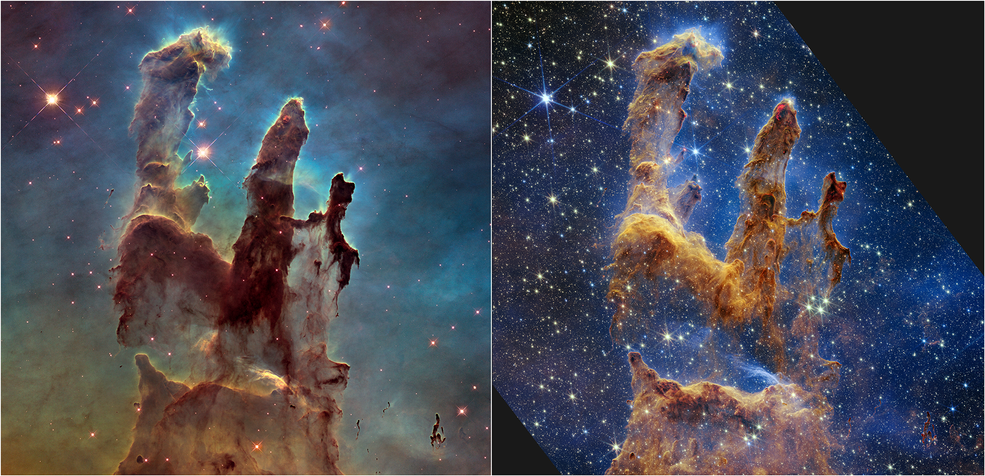The Fascinating Pillars of Creation
The Pillars of Creation, located within the vast Eagle Nebula some 6,500 light-years away, are a mesmerizing sight of interstellar gas and dust forming new stars. This intriguing region was first discovered by John Charles Duncan in 1920 and later captured by the Hubble Space Telescope in 1995, creating one of the most iconic images in astronomy.
The James Webb Space Telescope (JWST), launched in 2021, has now taken an even closer look at this region, providing valuable insights into the ongoing processes of star formation. With its advanced Near-Infrared Camera (NIRCam), the JWST has captured stunning, star-filled images of the Pillars of Creation, revealing details previously unseen.
Protostars and Cosmic Interactions
The NIRCam image captured by the JWST showcases numerous protostars, depicted as bright red orbs with eight diffraction spikes. These protostars form when knots of sufficient mass within the pillars collapse under their own gravity, slowly heating up and eventually shining brightly.
Along the edges of the pillars, wavy patterns resembling lava are visible. These patterns are actually ejections from stars that are still forming. Young stars periodically shoot out jets that interact with clouds of material, such as the thick pillars of gas and dust found in the Pillars of Creation. This interaction can result in bow shocks, creating wavy patterns similar to those produced by a boat moving through water.
The young stars responsible for these patterns are estimated to be only a few hundred thousand years old, and they will continue to form for millions of years.
New Insights into Star Formation
Although it may seem that the near-infrared light from the JWST has allowed us to “pierce through” the background and reveal great cosmic distances beyond the pillars, a translucent layer of gas in the interstellar medium obstructs our view of the deeper universe. This layer of gas also reflects the collective light from the numerous stars that have emerged from the pillars, illuminating the activity within.
These new observations from the JWST will help researchers refine their models of star formation. By identifying more precise star populations, as well as the quantities of gas and dust in the region, scientists can develop a clearer understanding of how stars form and burst out of these clouds over millions of years.
The Cultural Impact of the Pillars of Creation
The Pillars of Creation have had a significant impact on global culture since they were first captured by the Hubble Space Telescope. Their imagery has been featured on everything from t-shirts to coffee mugs, and they have inspired countless works of art, literature, and music.
the recent observations by the James Webb Space Telescope have provided us with a deeper understanding of the Pillars of Creation and the processes of star formation within this fascinating region. As research continues, we can expect even more revelations about the mysteries of the cosmos.





